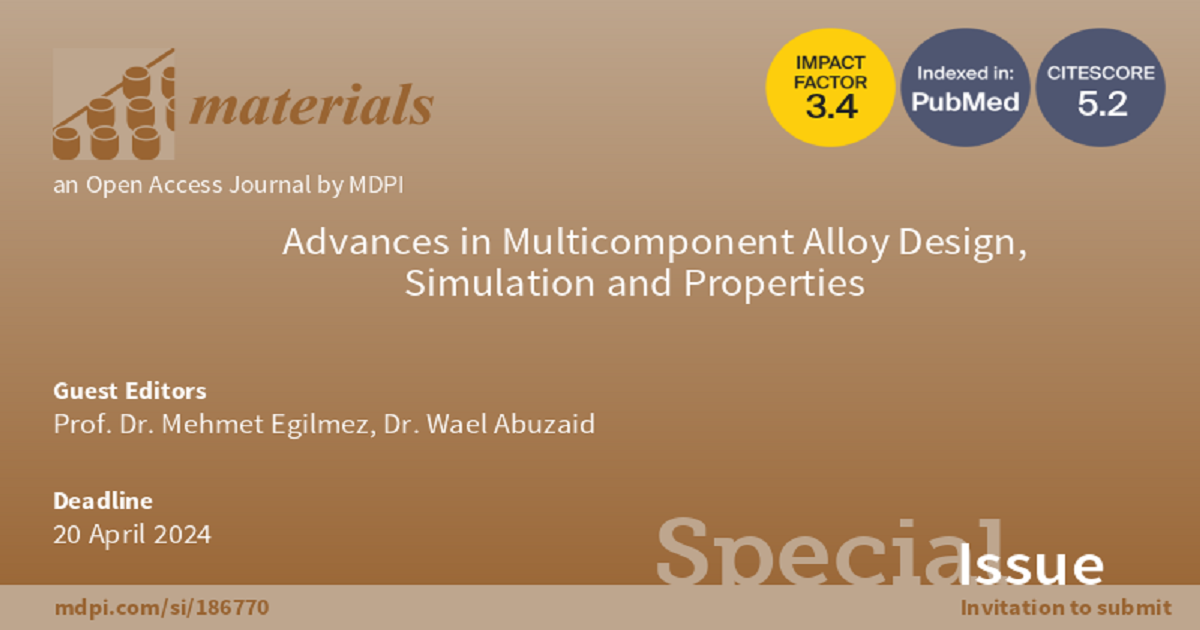Advances in Multicomponent Alloy Design, Simulation and Properties
A special issue of Materials (ISSN 1996-1944). This special issue belongs to the section "Metals and Alloys".
Deadline for manuscript submissions: 20 October 2024 | Viewed by 870

Special Issue Editors
Interests: electronic properties; magnetic properties; superconductivity; alloy design; structural properties and thin films
Interests: metallic materials; mechanical properties; high-temperature properties; cryogenic temperature properties; high-temperature high-entropy alloys; cryogenic-temperature alloys; high-temperature shape memory alloys
Special Issues, Collections and Topics in MDPI journals
Special Issue Information
Dear Colleagues,
Materials science research has a strong impact on technological advancement and pushing manufacturing towards industry 4.0 and the possible space era. Materials with versatile electronic, magnetic, and mechanical functionalities in extreme environments are in high demand; hence, the discovery of new materials and/or combinations of existing materials is essential. Conventional alloys generally relying on the presence of a single principal element and various minor constituents have been pushed toward their functional limits. Nearly two decades ago, new groups of materials, known as high-entropy alloys (HEA) and medium-entropy alloys, were introduced. The utilization of a large percentage of multiple principal constituent elements created unique alloying and composition optimization processes, in which materials with functionalities surpassing existing alloys could be realized. According to Boltzmann’s simple entropy formula, if the configurations in an alloy all have the same weighting or energy, the configurational entropy is given as S=kBLn(R), where S is the total configurational entropy, kB is the Boltzmann constant, and R is the number of possible configurations. It was suggested that the presence of multiple elements (in earlier studies, five or more elements were used) with near equiatomic ratios would maximize the configurational entropy to the degree required to overcome compound formation enthalpy and subsequently stabilize the solid solution state with relatively simple crystal structures. Recent experimental and theoretical studies revealed the importance of the low enthalpy of the mixing, in addition to the high-entropy criterion. The low-enthalpy criterion is very attractive, as it offers a wider compositional range that comprises alloys with fewer elements, as well as alloy structures that deviate from equiatomic compositions. Such progress led to the renaming of this group of alloys; nowadays, multicomponent alloy systems terminology is preferred over high-entropy alloy terminology. Such alloying techniques have had a significant impact on the design of new alloys with superior electronic, magnetic, mechanical, and electrochemical functionalities.
This Special Issue will bring together recent experimental and theoretical developments in the field of multicomponent alloys, including, but not limited to, alloy design and the electrical and magnetic, mechanical, and electrochemical properties of these alloys in bulk, single-crystal, and thin-film form.
Prof. Dr. Mehmet Egilmez
Dr. Wael Abuzaid
Guest Editors
Manuscript Submission Information
Manuscripts should be submitted online at www.mdpi.com by registering and logging in to this website. Once you are registered, click here to go to the submission form. Manuscripts can be submitted until the deadline. All submissions that pass pre-check are peer-reviewed. Accepted papers will be published continuously in the journal (as soon as accepted) and will be listed together on the special issue website. Research articles, review articles as well as short communications are invited. For planned papers, a title and short abstract (about 100 words) can be sent to the Editorial Office for announcement on this website.
Submitted manuscripts should not have been published previously, nor be under consideration for publication elsewhere (except conference proceedings papers). All manuscripts are thoroughly refereed through a single-blind peer-review process. A guide for authors and other relevant information for submission of manuscripts is available on the Instructions for Authors page. Materials is an international peer-reviewed open access semimonthly journal published by MDPI.
Please visit the Instructions for Authors page before submitting a manuscript. The Article Processing Charge (APC) for publication in this open access journal is 2600 CHF (Swiss Francs). Submitted papers should be well formatted and use good English. Authors may use MDPI's English editing service prior to publication or during author revisions.
Keywords
high-entropy alloys
mechanical properties
multi-principal element alloys
high-entropy alloy thin films
high-entropy alloy design
high-entropy alloy superconductors
cryogenic alloys







